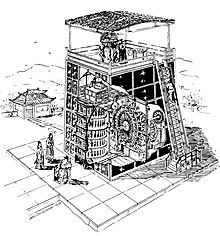
Back سو سونغ Arabic سو سونج ARZ Su Song AST Су Сун Bashkir Su Song Catalan Su Sung Czech Su Song German Su Song Esperanto Su Song Spanish Su Song Basque
Su Song | |
|---|---|
 | |
| Born | 1020 near Quanzhou city |
| Died | 1101 (aged 80–81) |
| Occupations | Scholar-bureaucrat
|
| Su Song | |||||||||||||
|---|---|---|---|---|---|---|---|---|---|---|---|---|---|
| Chinese | 蘇頌 | ||||||||||||
| |||||||||||||


Su Song (Chinese: 蘇頌; Pe̍h-ōe-jī: So͘ Siōng, 1020–1101), courtesy name Zirong (Chinese: 子容; Pe̍h-ōe-jī: Chú-iông),[1] was a Chinese polymathic scientist and statesman. Excelling in a variety of fields, he was accomplished in mathematics, astronomy, cartography, geography, horology, pharmacology, mineralogy, metallurgy, zoology, botany, mechanical engineering, hydraulic engineering, civil engineering, invention, art, poetry, philosophy, antiquities, and statesmanship during the Song dynasty (960–1279).
Su Song was the engineer for a hydro-mechanical astronomical clock tower in medieval Kaifeng, which employed an early escapement mechanism.[2][3][4][5] The escapement mechanism of Su's clock tower had been invented by Tang dynasty Buddhist monk Yi Xing and government official Liang Lingzan in 725 AD to operate a water-powered armillary sphere, although Su's armillary sphere was the first to be provided with a mechanical clock drive.[5][6][7] Su's clock tower also featured the oldest known endless power-transmitting chain drive, called the tian ti (天梯), or "celestial ladder", as depicted in his horological treatise.[8] The clock tower had 133 different clock jacks to indicate and sound the hours.[9] Su Song's treatise about the clock tower, Xinyi Xiangfayao (新儀象法要), has survived since its written form in 1092 and official printed publication in 1094. The book has been analyzed by many historians, such as the British biochemist, historian, and sinologist Joseph Needham. The clock itself, however, was dismantled by the invading Jurchen army in 1127 AD, and although attempts were made to reassemble it, the tower was never successfully reinstated.
The Xinyi Xiangfayao was Su's best-known treatise, but the polymath compiled other works as well. He completed a large celestial atlas of several star maps, several terrestrial maps, as well as a treatise on pharmacology. The latter discussed related subjects on mineralogy, zoology, botany, and metallurgy.
European Jesuit visitors to China like Matteo Ricci and Nicolas Trigault briefly wrote about Chinese clocks with wheel drives,[10] but others mistakenly believed that the Chinese had never advanced beyond the stage of the clepsydra, incense clock, and sundial.[11] They thought that advanced mechanical clockworks were new to China and that these mechanisms were something valuable that Europeans could offer to the Chinese.[11] Although not as prominent as in the Song period, contemporary Chinese texts of the Ming dynasty (1368–1644) described a relatively unbroken history of mechanical clocks in China, from the 13th century to the 16th.[12] However, Su Song's clock tower still relied on the use of a waterwheel to power it, and was thus not fully mechanical like late medieval European clocks.
- ^ Harrist, 239, footnote 9.
- ^ Needham, Volume 4, Part 2, 445.
- ^ Needham, Volume 4, Part 2, 448.
- ^ Bodde, 140.
- ^ a b Fry, 10.
- ^ Needham, Volume 3, 351.
- ^ Cite error: The named reference
bowman 105was invoked but never defined (see the help page). - ^ Needham, Volume 4, Part 2, 111.
- ^ Needham, Volume 4, Part 2, 165.
- ^ Needham, Volume 4, Part 2, 438.
- ^ a b Needham, Volume 4, Part 2, 435–440.
- ^ Cite error: The named reference
needham volume 4 part 2 509 512was invoked but never defined (see the help page).
© MMXXIII Rich X Search. We shall prevail. All rights reserved. Rich X Search